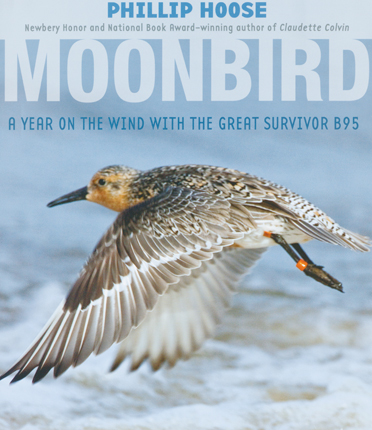Full Text Reviews: Booklist - 06/01/2012 *Starred Review* Hoose, the author of The Race to Save the Lord God Bird (2004) and the heavily awarded Claudette Colvin: Twice toward Justice (2009), now turns his attention to another endangered bird, the rufa red knot. He focuses on one, B95 (dubbed Moonbird by researchers), which he calls “one of the world’s premiere athletes,” explaining that though “weighing a mere four ounces, he’s flown more than 325,000 miles in his lifetime.” Each year red knots like Moonbird fly from their winter home in Tierra del Fuego, Argentina, to their breeding grounds in the Canadian Arctic, a journey of 9,000 miles. B95, now 20 years old, has made this remarkable flight 18 or more times. In this beautifully written and meticulously researched book, Hoose provides a complete account of the red knots’ physiology, their flight patterns, feeding habits, habitats, and more. He also writes about those who study the birds and struggle to preserve the endangered species, which has dwindled in numbers from some 150,000 to less than 25,000. In addition to his attention to the birds, Hoose profiles those who study them and also provides a generous number of photographs, maps, and sidebar features that dole out background and ancillary material. His appendix includes elaborate source notes and an extensive bibliography. Sure to be one of the most well-received information books of the year, and deservedly so. HIGH-DEMAND BACKSTORY: Hoose’s stature as a preeminent nonfiction author combined with the high-interest animal hook will generate hearty attention and enthusiasm for this one. - Copyright 2012 Booklist. School Library Journal - 10/01/2012 Gr 6 Up—Moonbird is a nickname scientists have given to a small Eastern shorebird known for both his unusually long life and his enormously long annual migration. Hoose intertwines the story of this bird's remarkable survival with detailed accounts of the rufa red knot's physical changes through its yearlong cycle of migrating from the bottom of the world (usually Tierra del Fuego) to its Arctic breeding grounds and back again at summer's end-a round trip of some 18,000 miles. Moonbird, known usually by the identifying label "B95" on his orange leg band, was first banded in 1995, when it was thought that he was at least three years old, and Hoose notes sightings of him through early 2011 just as the book was reaching completion. At that point it was estimated that over 20 years' time, B95 had flown "more than 325,000 miles in his life-the distance to the moon and nearly halfway back." The feat is particularly celebrated among bird scientists because this species is rapidly declining as humans use and misuse its feeding grounds and food supply. The threatened state of the species and the personal work being done by scientists and conservationists are strong themes throughout the book. Hoose describes his own experiences participating in study trips and introduces children and teens engaged in study, conservation, and lobbying projects in Canada, the United States, and Argentina. This deeply researched, engaging account is a substantial and well-designed package of information illustrated with handsome color photographs, ample maps, appended descriptions of the conservation work, and thorough source notes.—Margaret Bush, Simmons College, Boston - Copyright 2012 Publishers Weekly, Library Journal and/or School Library Journal used with permission. Bulletin for the Center... - 09/01/2012 The rufa red knot “has to be among the toughest four ounces of life in the world.” The tiny shorebird chows down several times its weight in mussels during the warm months of the Patagonian “winter,” then begins its nine-thousand-mile marathon flight to its breeding ground near Hudson Bay, making several rest and refueling stops along the way and arriving just in time for warming weather in the far North. Then it’s nine thousand return miles, a few months of R & R, and time to hit the road—well, sky—again. The red knot leg-tagged as B95 is the reigning champion among these avian athletes, at least eighteen years old at the time of Hoose’s 2010 investigation and still going strong. Hoose reviews the known data about the rufa red knots’ flight paths and stopovers and combines it with information about B95 sightings to imagine how the diminutive creature weathers the brutal flight year after year after year. Not only does B95 survive storms and predators, but he also seems impervious to the forces (particularly tourism at feeding sites and over-harvesting of horseshoe crabs, whose eggs provide a vital source of nourishment) that are diminishing the population to the point of getting the birds on many endangered species lists. Putting an actual beaked face to the problem of animal endangerment makes the story of the species’ peril all the more compelling, and only the truly hard of heart could resist cheering for B95 to make it through one more trip. Each chapter, which traces a leg of the round trip journey, features a wealth of photographs (color in the bound book) and a profile of a scientist, advocate, or guardian of the rufa red knot’s cause. Source notes, a bibliography, and an index are included. (Psst. B95 was sighted at Reeds Beach in May of this year, but keep that spoiler to yourself and let readers Google their own way to an update.) EB - Copyright 2012 The Board of Trustees of the University of Illinois. Loading...
|




